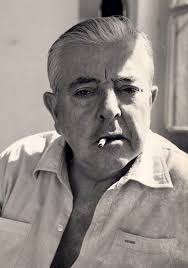
Jacques Prèvert (1900, 4 février - 1977, 11 avril)
Images by Margaret Suchland
Pour faire le portrait d'un oiseau
Peindre d'abord une cage
avec une porte ouverte
peindre ensuite
quelque chose de joli
quelque chose de simple
quelque chose de beau
quelque chose d'utile
pour l'oiseau
placer ensuite la toile contre un arbre
dans un jardin
dans un bois
ou dans une forêt
se cacher derrière l'arbre
sans rien dire
sans bouger ...
Parfois l'oiseau arrive vite
mais il peut aussi bien mettre de longues années
avant de se décider
Ne pas se décourager
attendre
attendre s'il le faut pendant des années
la vitesse ou la lenteur de l'arrivée de l'oiseau
n'ayant aucun rapport
avec la réussite du tableau
Quand l'oiseau arrive
s'il arrive
observer le plus profond silence
attendre que l'oiseau entre dans la cage
et quand il est entré
fermer doucement la porte avec le pinceau
puis
effacer un à un tous les barreaux
en ayant soin de ne toucher aucune des plumes de l'oiseau
Faire ensuite le portrait de l'arbre
en choisissant la plus belle de ses branches
pour l'oiseau
peindre aussi le vert feuillage et la fraîcheur du vent
la poussière du soleil
et le bruit des bêtes de l'herbe dans la chaleur de l'été
et puis attendre que l'oiseau se décide à chanter
Si l'oiseau ne chante pas
c'est mauvais signe
signe que le tableau est mauvais
mais s'il chante c'est bon signe
signe que vous pouvez signer
Alors vous arrachez tout doucement
une des plumes de l'oiseau
et vous écrivez votre nom dans un coin du tableau.
Oneness, acrylic and collage (including old Japanese map) by Donna Watson
Hogyan fessünk madarat?
Fessünk először egy kalitkát,
az ajtaját szélesre tárva,
s fessünk aztán
valami kedveset,
valami egyszerűt,
valami szépet,
valamit, ami hasznos
a kismadár szemének,
s támasszuk aztán egy fának a vásznat
egy kertben,
egy erdőben,
vagy egy rengetegben,
s rejtőzzünk a fa mögé semmit se szólva,
sőt mozdulatlan.
Néha gyorsan odajön egy madár,
de olykor hosszú évek is elmúlnak,
míg elhatározza magát, hogy leszáll.
Ne veszítsük el a türelmünk,
várjunk, merengjünk.
Várjunk, ha kell, éveken át,
száz év nem a világ,
hogy gyorsan vagy lassan jön-e meg a madár,
nincs semmi összefüggésben vele,
hogy lesz-e a képnek majd sikere.
Amikor megjön a madár,
– ha megjön a madár –
mélységes csendben legyünk,
várjuk meg, amíg a kalitkába belép,
s bent van, ha már besétált egyszer,
zárjuk be ajtaját gyorsan az ecsettel.
Aztán tüntessünk el minden rácsot vigyázva,
nehogy egy csöpp is hulljon a madárra.
Fessünk aztán egy tündéri szép fát,
s a legszebb ágat
válasszuk a madárnak.
Fessük meg a zöld lombokat, a borzoló szelet,
a napban táncoló porszemeket,
a fű bogarainak zsivaját a nyári melegben,
s várjuk meg, amíg a madár dalolni kezd önfeledten.
Ha nem dalolna a madár,
rossz jel volna, azt mutatná meg - óóó -
hogy a kép rossz, csapnivaló.
De jó jel az, ha a csőre dalra rebben.
Akkor egy tollat a gyerek
a madár szárnyából gondosan kitéphet,
s aláírhatja vele boldogan
a képet!
Fordította: Végh György
Japan - coffret made with lacquer, Meiji Period
To make a portrait of a bird
First paint a cage
with an open door
then paint
something pretty
something simple
something beautiful
something useful
for the bird
then place the canvas within a tree
in a garden
in a wood
or in a forest
hide behind the tree
without saying anything
without moving an inch…
Sometimes the bird arrives quickly
but he can also take many years
before deciding
do not become discouraged
wait
wait for years if you have to
the speed or the sluggishness of the bird’s arrival
has no effect
on the outcome of your painting
When the bird arrives
if it arrives
keep the most profound silence
wait for the bird to enter the cage
and when he is inside
gently close the door with the paintbrush
then
erase all of the bars one by one
while taking care not to touch any of the bird’s feathers
then do the tree’s portrait
choosing the most beautiful branch
for the bird
paint the greenery and the freshness of the wind as well
the spray of the sun
and the noise of the animals in the grass in the heat of summer
and then wait for the bird to decide to sing
If the bird doesn’t sing
it’s a bad sign
it’s a sign that your painting is bad
but if it sings it’s a good sign
it’s a sign that you can sign
Then you very gently pluck
one of the bird’s feathers
and you write your name in a corner of the canvas.
Translated by Emil Adam
China - fragment of silk embroidered cloth, Ming Dynasty
Kako sačiniti portret ptice
Elzi Anrikez
Prvo naslikati kavez
sa otvorenim vratima
zatim naslikati
nešto ljupko
nešto jednostavno
nešto lepo
nešto korisno
za pticu
zatim postaviti platno uz drvo
u vrtu
u šumarku
u šumi
sakriti se iza drveta
bez reči
bez pokreta...
Ponekad ptica dođe brzo
ali može da prođe i nekoliko godina
pre no što se reši
Ne gubiti hrabrost
čekati
čekati ako treba godinama
budući da brzina ili sporost dolaska ptice
nemaju nikakve veze
sa time da li je slika uspela
Kad ptica dođe
dočekati je u najdubljoj tišini
sačekati da ptica uđe u kavez
a kad uđe
blago zatvoriti vrata kičicom
zatim
obrisati sve rešetke jednu za drugom
pazeći da ne dodirne nijedno pero ptice
Onda načiniti portret drveta
birajući najlepšu granu
za pticu
naslikati takođe zelenu krošnju i svežinu
vetra
uskovitlanu prašinu u sunčevom zraku
zujanje buba u travi toplog leta
a onda sačekati da se ptica reši da peva
Ako ptica ne zapeva
to je loš znak
znak da je slika loša
ali ako zapeva to je dobar znak
znak značajan da je možete potpisati
Onda vrlo nežno otrgnete
jedno pero od ptice
i ispišete svoje ime u uglu slike.
Prevod: Radivoje Konstantinović
Nincsenek megjegyzések:
Megjegyzés küldése